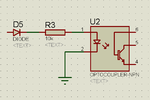bagusdj
Member level 3
Hi guys, I want to ask about getting right value based on datasheet reading
View attachment 4n26.pdf
here is the suggested interfacing method.

what i see here:
1. 1 is pin 1, 2 is pin 2, 3 is pin 5, 4 is pin 6.
2. the output is going to MCU at89s52 (the output must have less or equal to 10mA), 2 & 4 goes to ground (but not the same ground; 4 goes to MCU's ground while other goes to input's ground)
3. pin 3 & 6 is not connected.
what i want to ask, what voltage should be applied to input? based on data sheet mentioned max of iF is 80mA,but in other tables mentioned typical and max voltage WHEN iF=10mA. which one i have to assign, so i know what is the value of Rd.
for other side, it said vcc (5Volt); what is the value of current required in 3 (pin 5)?
View attachment 4n26.pdf
here is the suggested interfacing method.

what i see here:
1. 1 is pin 1, 2 is pin 2, 3 is pin 5, 4 is pin 6.
2. the output is going to MCU at89s52 (the output must have less or equal to 10mA), 2 & 4 goes to ground (but not the same ground; 4 goes to MCU's ground while other goes to input's ground)
3. pin 3 & 6 is not connected.
what i want to ask, what voltage should be applied to input? based on data sheet mentioned max of iF is 80mA,but in other tables mentioned typical and max voltage WHEN iF=10mA. which one i have to assign, so i know what is the value of Rd.
for other side, it said vcc (5Volt); what is the value of current required in 3 (pin 5)?

